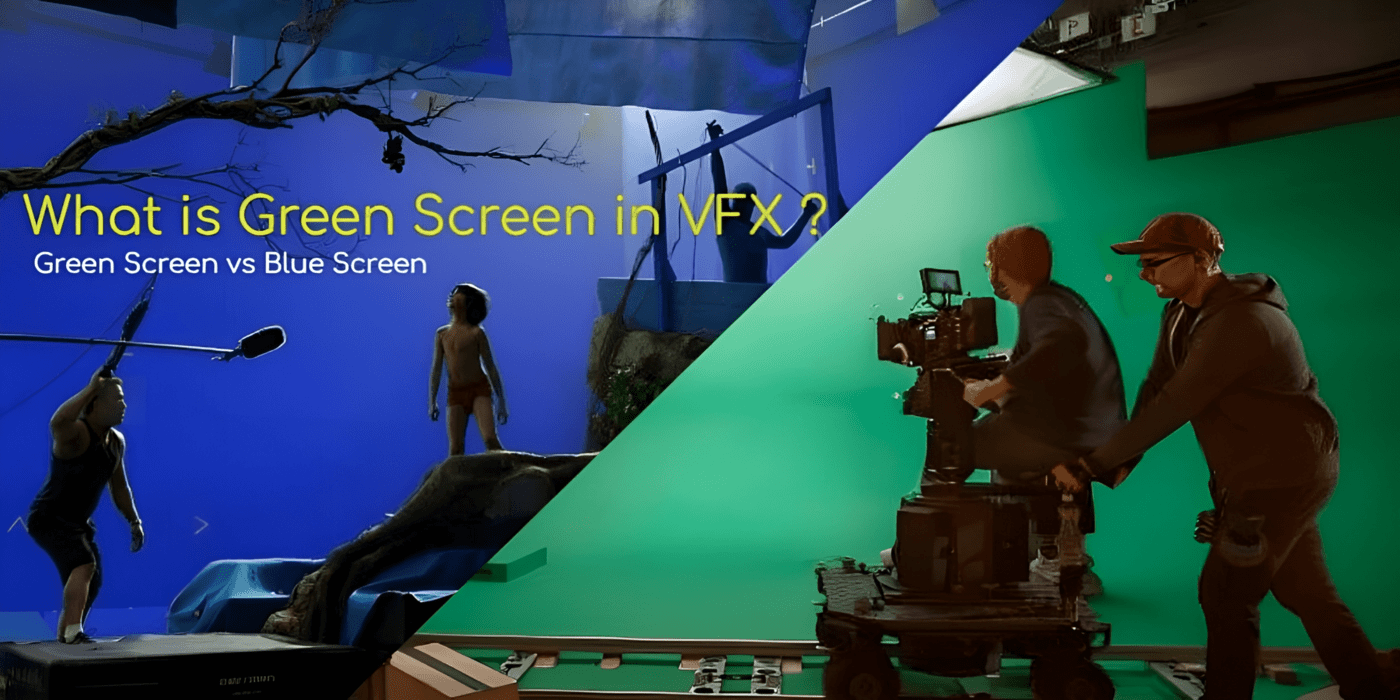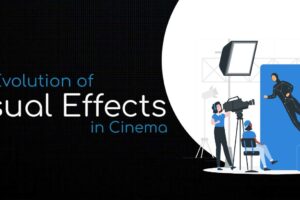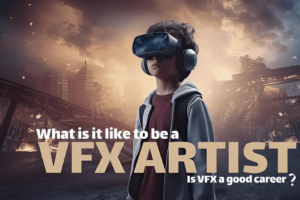
What is Green Screen? Learn why is Green Screen used in VFX.
What is Green screen?
Green screens, also known as chroma keying, is a VFX technique that is used for compositing two or more images or video branches together based on chroma range or color hues. This technique has been used in many areas of film, to remove a background from the photo/video. This has transformed the film industry, allowing effortless integration of actors with digital backgrounds. This technology provided immense post-production flexibility, empowering directors to envision and craft complex scenarios without physical set limitations. However, despite their revolutionary impact, green screens still faced certain constraints. Actors often struggled to perform convincingly in front of the screen. The directors also face challenges in accurately visualizing the final scene during filming. Like the Green screen, the Blue screen is also used for shooting several movie scenes. This has made some arguments among the artists about the differences between Green Screen vs Blue Screen.
When was the green screen invented?
The visual effects method commonly referred to as chroma key or Green screen. This has been a longstanding practice in the cinema and television industries. Filmmakers can use it to superimpose one image or video over another by substituting a different image or video for a background that is solidly coloured. Although the green screen was initially developed in the 1940s, its ubiquitous use really took off in the 1980s, when more reasonably priced computer graphics became available. The film industry adopted the green screen for special effects production in the 1940s, which was in fact one of its first applications.
Green Screen vs Blue Screen, which is better
The green screens are best suited for daylight shooting whereas blue screens are more apt for night lightings. Blue screens also come in handy when the character or subject is green in colour. The blue screen is widely used as there were less spillage issues comapared to green screens. But the neon green is difficult to match with constume, skin tone, hair colour or any other subject colour unlike blue colour. Thus both screens were used as per the needs.
Science fiction movies like “Star Wars” and “Star Trek” also make considerable use of the blue screen method to give the spacecraft models a realistic appearance. To create the finished video, the models are shot independently on blue backdrops and then composited into several layers. There are hundreds of layers in these extremely intricate photos.
We all have undoubtedly witnessed poor blue screen technique execution in television programs when the background plate is diffused and the subject performer is sharply defined. The mismatch will easily let you know it’s fake right away. The actor or model cannot be affected by the color of the blue screen. If it does, the performer develops an ugly blue “fringe” around the borders.
The performer is not allowed to wear anything blue or remotely related to blue since it will appear as a hole in them heralding fakeness. Blue screen photos are even simpler to take with a computer because it can automatically construct the mattes and mix the photographs. Now we can lot at the key differences between Green Screen vs Blue Screen;
Difference Between Green Screen vs Blue Screen
| Features | Green Screen | Blue Screen |
| Color Spill | More spill can affect the edges of hair or clothing | Less spill, better for fine details near the background |
| Digital Cameras | More sensitive, and easier to key out | Less sensitive, it can be trickier to key out |
| Cost-effectiveness | More cost-effective due to lower lighting needs | More expensive due to lighting needs |
| Lighting Requirements | Needs less lighting | Needs more lighting |
| Common Uses | Daytime shoots, the most common choice | Night shoots, working with physical film, avoiding blue clothing |
why is green screen used for vfx
There are mainly two reasons to use green screens in VFX;
- Color Separation: Green shades are different from common human skin tones and clothing colors. This minimizes the risk of unpredicted elements like green shirts..etc. which might be accidentally replaced during the editing process.
- Camera Sensitivity: Camera sensors have the tendency of capturing green light better than human eyes do. As a result, the green screen will get better and more even lighting. Thus minimizing the shadows or improper lighting that could be challenging for the VFX in the future.
In the earlier days of cinematography, blue screens were also adopted but green seemed to be the better choice for videos. This is because of the availability of more green sensors (sensitivity) in video cameras.
The Evolution of VFX
In the early days of filmmaking, practical effects such as miniatures, matte paintings, and puppets were the primary methods used to create fantastical worlds and creatures on screen. While these techniques were groundbreaking for their time, they often had limitations in terms of realism and flexibility.
The advent of CGI in the 1970s and 1980s revolutionized filmmaking. This enables the directors to generate digital worlds and characters that were unattainable with traditional practical effects. However, early CGI faced criticism for its artificial appearance and poor integration with real-life footage. For decades, the green screen technique has been widely used in filmmaking. Even props were painted neon green to allow for the seamless integration of visual effects that replaced physical objects.
Green Screen to LED/Virtual Sets: The Industry Transformation
Visual effects (VFX) have come a long way to the day visual effects start dominating the film industry. With advancements in technology, particularly in computer-generated imagery (CGI) and augmented reality (AR), filmmakers now have an array of tools at their disposal to create immersive worlds and breathtaking scenes. One of the most significant developments in recent years has been the shift from traditional green screens to virtual LED sets. This have been continuously revolutionizing the way movies and television shows are made. The introduction of green/blue screen background has been a pivotal point in the history of visual effects. From the relevance of green/blue screens to the development of LED screens, VFX techniques apparently has gone a long way.
Green screen refers to, a big, flat surface painted or coated in neon-green cloth. It is positioned behind the subjects or necessary objects to be filmed, producing a consistent background that can be drastically changed in post-production to a different picture or clip. Chroma keying, is the act of removing the green color from the source video and turning it translucent in order to place the desired background behind the foreground parts.
Virtual Set
Virtual sets, combining the real and digital realms, have emerged as a solution to film production challenges. Actors perform on a stage surrounded by LED screens that display virtual environments in real-time, eliminating the need for green screens. This “virtual production” allows directors to view the final shot during filming, enhancing decision-making and on-set collaboration.
Advantages of Virtual Sets: –
- Real-Time Feedback: Directors can observe the final composition as it’s being filmed, enabling prompt decision-making and adjustments.
- Enhanced Actor Performances: Actors can instantly interact with digital surroundings, enriching their acting and making them feel more connected to the story.
- Cost Savings: Virtual sets require a one-time equipment investment but can significantly reduce expenses by minimizing the need for post-production.
- Creative Flexibility: Virtual sets can be rapidly modified to meet the demands of multiple scenes and productions, allowing filmmakers to explore a wider range of creative possibilities.
What does the Future of VFX Looks Like?
With rapid technological advancements, the realm of visual effects in filmmaking is poised for an exciting future. Virtual sets and LED screens exemplify the transformative power of technology, opening up boundless possibilities for filmmakers to craft immersive and visually stunning experiences.
Advanced technologies like augmented reality (AR) and virtual reality (VR) are poised to transform the future of visual effects. With these tools, filmmakers can create captivating experiences that immerse audiences like never before. AR and VR have the power to not only change how movies and TV shows are crafted, but also how viewers experience them.
Recent breakthroughs in machine learning and artificial intelligence are empowering filmmakers. They can now produce more realistic and stunning visual effects, enhancing the impact of their films. From lifelike digital characters to dynamic simulations, AI-based tools are pushing the limits of what’s possible in visual effects, creating breathtaking experiences for audiences.
Undoubtedly, visual effects production has undergone a remarkable evolution. That started from the early days of sedulous work in practical effects to the rise of virtual sets. In this ongoing story, we’re currently in the page of virtual sets that represent the latest chapter. Offering filmmakers unprecedented creative freedom and flexibility. As technology continues to advance, the future of visual effects production looks brighter than ever. This promises an even more immersive and captivating cinematic experiences for audiences all over the world.
Conclusion
In this blog, we have discussed about the differences between Green Screen vs Blue Screen and what is Green Screen in VFX? The technologies will continue to change and the only thing that is constant is change itself. Technology continues to advance, so did the capabilities of visual effects. Technology will keep changing no matter what.Today’s latest virtual/LED screen will also be replaced with a more useful technique someday. Although, these developments in the respective periods are indeed instrumental for the overall progress of the Visual effects. The VFX studios are still discovering the new realms they can explore.



